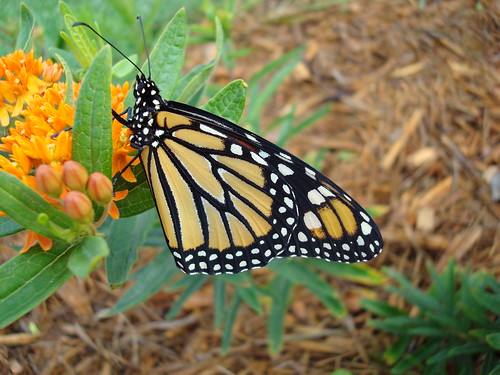
With a view of majestic mountains in the background, visitors to the Cranberry Mountain Nature Center of the Monongahela National Forest find themselves immersed in a bevy of beautiful plants in bloom and fluttering monarch butterflies. Beneath the natural grandeur, a very essential ecosystem service is taking place – pollination.
In celebration of National Pollinator Week, June 17-21, 2013, the Forest Service invites you to come and visit the beautiful gems called Native Plant and Pollinator gardens currently in bloom in the Eastern Region.
All 15 units of the Eastern Region have developed at least one garden – some have as many as 14. Selected gardens offer guided tours and all are highlighted by educational signs.
Native Plant and Pollinator gardens are sources for local native seeds for restoration, as well as sites for interpretation. Pollinators include ants, bats, bees, beetles, birds, butterflies, moths and wasps.
In addition to providing nectar and larval food to pollinators, these gardens also serve as rain collectors, slowly releasing rain water into the ground. They also provide habitat for wildlife, and serve as living classrooms for local students and the public. They tell the important story of the significance of our native flora, pollinators and pollination.
Many volunteers and visitors are affected by the ecosystem benefits provided by the Native Plant and Pollinator gardens, and are inspired to use the skills they honed there in their own backyard pollinator gardens.
Plant and Pollinator Garden Factoids:
- Most gardens include several species of wildflowers and grasses.
- The gardens offer a close-up view of native wildflowers and pollinators at work.
- The gardens provide habitat and pollen and nectar resources for native insects and hummingbirds.
- Visitors to the Chequamegon-Nicolet National Forest headquarters’ garden will catch a glimpse of barrens strawberries, bee balm and golden rod.
- Great Divide garden of the Chequamegon-Nicolet National Forest features Eastern bluebird houses.
- Even in the winter, the gardens are providing seeds for birds.
- At the Park Falls Office, numerous pollinators have been spotted since installation of the gardens, including the monarch caterpillar.
- Gardens feature a mix of native fobs, shrubs, grasses and seed; examples include common butterfly milkweed, hazelnut, little bluestem and big bluestem.
- A lot of the gardens in the region feature rain barrels that capture rain water to hydrate the gardens and bird and butterfly houses.
- Bowman Lake Pollinator garden on the Huron-Manistee National Forest is a registered Monarch Waystation.
- Nearly 10,000 people visit the Lake Michigan Recreation Area garden of the Manistee National Forest every year.
- The Huron-Manistee’s Lumberman’s monument garden overlooking the beautiful Au Sable River, has over 30 native nectar and hosts plants for pollinators, such as cardinal flower and northern blazing star.
Don’t be afraid to buzz around your local national forest, who knows, you might see a pollinator!

